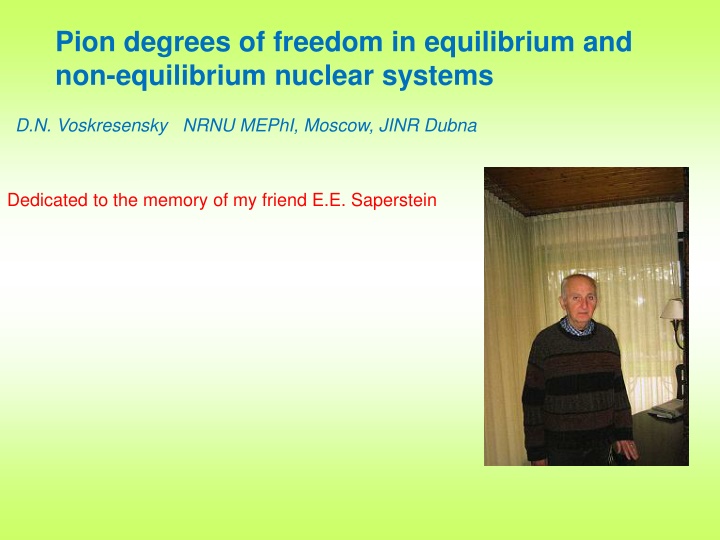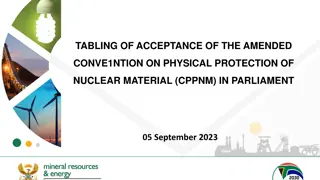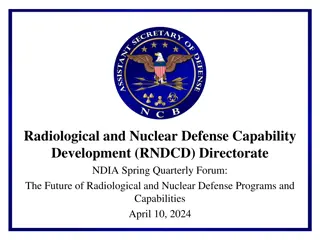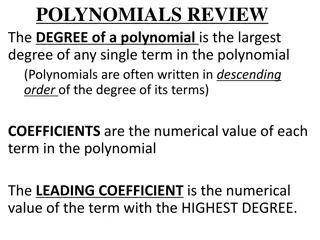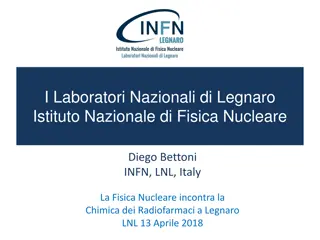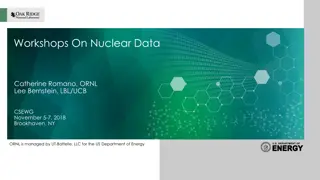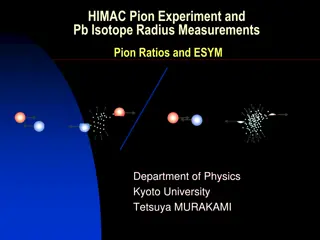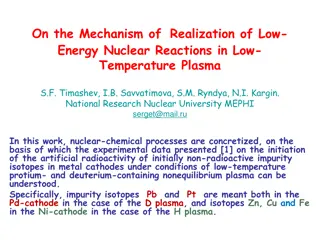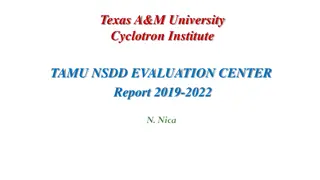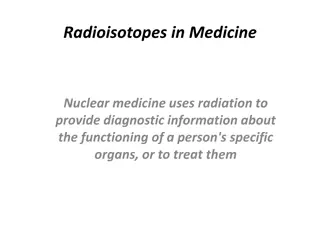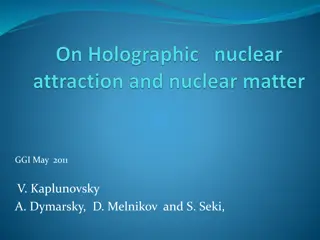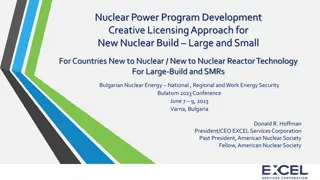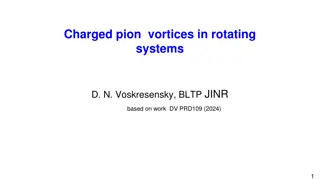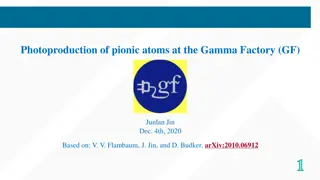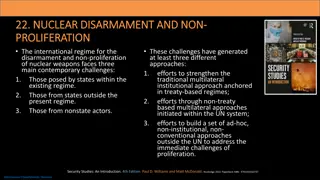Pion Degrees of Freedom in Nuclear Systems
This content presents a historical review of pion degrees of freedom in equilibrium and non-equilibrium nuclear systems, exploring their effects in various contexts and highlighting key research contributions from Moscow over different time periods.
Uploaded on Feb 22, 2025 | 1 Views
Download Presentation

Please find below an Image/Link to download the presentation.
The content on the website is provided AS IS for your information and personal use only. It may not be sold, licensed, or shared on other websites without obtaining consent from the author.If you encounter any issues during the download, it is possible that the publisher has removed the file from their server.
You are allowed to download the files provided on this website for personal or commercial use, subject to the condition that they are used lawfully. All files are the property of their respective owners.
The content on the website is provided AS IS for your information and personal use only. It may not be sold, licensed, or shared on other websites without obtaining consent from the author.
E N D
Presentation Transcript
Pion degrees of freedom in equilibrium and non-equilibrium nuclear systems D.N. Voskresensky NRNU MEPhI, Moscow, JINR Dubna Dedicated to the memory of my friend E.E. Saperstein
Plan A historical review. Pion cond. and abnormal nuclei and phase transition in NS. A general description of pions in baryon matter. Pion softening effects in HIC. Pion softening effects in problem of neutrino radiation of NSs, and in problem of damping of r-modes.
1961 work under the guidance of A.B. Migdal on theory of finite Fermi systems. Pion degree of freedom was not treated explicitly that time.
Pion degree of freedom in hadron matter history in Moscow time, in brief: 1971 A.B. Migdal ZhETF : pion cond. in strong fields, with ideas of pi-cond. in dense nuclear matter, and possibility of superdense pi-cond. nuclei. 1971-1978 I period. 1972 Migdal: P-wave pion cond. in dense nuclear matter. Are middle-heavy and heavy nuclei similar to liquid crystals or crystals? Pi-cond. in NS. 1974 Migdal, Markin, Mishustin JETP: Pion mode in cold dense nuclear matter. 1975-1978 Saperstein, Troitsky, Fayans, Tolokonnikov : no pion cond. in at. nuclei. But pion excitation mode is soften in nuclei. 1976 Migdal, Popov, D.V., 1977 Chernoutsan,Sorokin, D.V.: Relativistic semicl. approx. for Dirac eq., suggested nuclei-stars glued by --cond. and e-. 1978 Migdal Rev.Mod.Phys., book (in Rus.) `Fermions and bosons in strong fields.`
Pion degree of freedom in hadron matter history in Moscow time, in brief: 1978-1983 II period. 1978-1983 Saperstein, Troitsky, Fayans, Tolokonnikov, Borzov et al. recalc. Landau- Migdal param. at inclusion of pi-mode in support of idea of pion softening in nuclei. 1978 Migdal, Chernoutsan, Mishustin I-order pi-cond. phase tr. in NS, blowing off a matter. 1978 Mishustin, D.V. Pion degree of freedom in nucl. matter at T 0. 1982,1983 Dyugaev : liquid (fl.) and solid phases of pi-cond. for T 0. 1980 Anisimov, D.V. JETP, pi--cond. superconductivity in NS, Layer str. in mag. fields. 1982 Saperstein and Khodel Phys.Rep.: Self-consistent theory of finite Fermi systems. Migdal 1983: II ed. book `Theory of finite Fermi systems. .. (in Rus. ) Saperstein and Khodel helped him a lot.
Pion degree of freedom in hadron matter - history in Moscow time, in brief: 1983-1990 III period. 1981 Nagamiya PRC: Results of HIC exp. on Bevalac. - Ideal gas models. 1984 Schulz, D.V. In-medium effects in pion production in HIC. 1984 Koldaev, Troitsky, Khodel. Localized states of pions and kaons in nuclei. 1986 Senatorov,D.V. Pion in-medium effects in problem of cooling of NS. 1987 Senatorov, D.V.,K mpfer, Haubold: second neutrino burst as result of pi-cond. tr. during supernova explosion. 1989 D.V.: liquid phase of -cond. & pion softening in HIC below 2GeV A energies. 1990 Migdal, Saperstein, Troitsky, D.V. 3-volums Phys.Rep. , 1991 book in Rus. `Pion degrees of freedom in nuclear matter`. 1990 Migdal: Program: QCD-deformed nucleon string with pion tail. in vac. and in hadron medium (worked on that with Saperstein and me, not finished, not publ.)
Pion condensation, superheavy nuclei and nuclei-stars Superdense and supercharged nuclei, nuclearites, compact stars with pi-cond. Migdal ,ZhETF1971,1974, Migdal, Popov, D.V. JETP Lett.1976, Chernoutsan, Sorokin, D.V. 1977. D.V.1977 in PhD thesis: if there were -charged light bosons with mass m b nuclei-stars with n~n0 For |V| mb, n p+b-, charge-neutral interior for A~Z>>1/e3 , and surf. layer with field strength E~102Eel~1018v/cm. instead of Coulomb charged boson In realistic N interaction problem m m* (km (n)) 1979 Troitsky, Chekunaev, and hyperon enreached superdense nuclei with -cond. Quark strange nuggets, strange stars 1984 Witten, Farhi, Jaffe,De Rujula, Glashow 1988 Bethe,Brown, Cooperstein, hybrid stars 1984 Glashow charged DM champs 2005 Glashow, U tera-quarks and O-{UUU} (e=-2) baryons, 2006 Khlopov, mO~1TeV, OHe DM 2019 Gani, Khlopov, DV, DM O-nuclearites,
Compact stars with pion condensate Superconductivity of -condensate in NS [D.V., Anisimov, Sov.Phys.JETP 51 (1980) 13] vortices are not threads but slabs (k~pFn, H-plane) in magnetic field, Hc2~ pFn2/e ~ 10 19G Estimate of H in peripheral HIC at ~GeV/A as ~ 10 17-10 18G : supported by detailed calcul. by Skokov, Illarionov,Toneev 2009 Magnetars: observed 1998: have at surface H~ 10 15G, with dynamo mech. in interior H up to ~10 18G, so --cond. survives. Sheet-mixed-state in rotating NS. Possibility of the van-der-Waals EOS due to pi-cond.: consequences for supernova explosions: blowing off part of matter, Migdal, Chernoutsan, Mishustin, Phys. Lett. B83 (1979) ttr~10-3sec. Question of D.Pines: check that NS M max>1.4Msol, (Max NS mass constraint now M>1.97Msol) Weaker tr.: strong glitches, strong NS kicks [Haensel, Proszynski, Phys. Lett. B96 (1980)] Similar consequences for Q-tr. In hybrid stars. 2-nd neutrino burst if tr. occurred during supernova explosion [Haubold, K mpfer, Senatorov, D.V., 1987 ttr~10 sec. h.
Dynamics of I order phase transition near critical point (nuclear liquid-gas, quark-hadron (?), -condensate tr. ) Viscosity is driving force of ph. tr. bulk shear From Navier-Stokes and continuity equations neglecting u2 terms: F / +d 3 D.V. Phys.Scripta 47 (1993) 333 cf. Ginzburg-Landau =mn For liquid-gas tr. c>0, for pion cond. tr. c<0, d>0. F-expansion near critical point but in mean field approximation s - is entropy density Slow tr.process: T s/ t = T, initially spherical pi-cond.seed deforms: stick-like structures observed in A-smectics Similar subjects - chiral nonuniform phases in quark matter: Tatsumi, Nakano 2004, Nickel 2009, quarkyonic matter McLerran, Pisarski 2007.
In NS an overcritical drop reaches size R~0.1 km for t~10-3sec. by growing of density mode, then it reaches R~(1-10) km for t~10 sec. h. (rather than collapse time 10-3sec for R~10 km.) owing to neutrino heat transport to the surface (effect of thermal conductivity) for T~ 10 MeV. D.V., Senatorov, K mpfer, Astroph. Space Sci. (1988), Migdal, Saperstein, Troitsky, D.V. Phys. Rep. (1990)
Fermi liquid approach: separation of soft and hard modes pion with residual (irreducible in NN-1and N-1) s-wave N interaction and scattering`` explicit nucleon-nucleon hole and Delta-nucleon hole degrees of freedom Part of the interaction involving isobar is analogously constructed: small
Low energy excitations in nuclear Fermi liquid (Migdal approach) based on a separation of long and short scales Info. on short-range interact. is extracted from analysis of atomic nuclei exp. Migdal Rev.Mod.Phys. 50, 1978, Migdal,Saperstein,Troitsky,D.V. Phys.Rep.190 (1990).
Neutral pion propagator for n c >n> n c1~0.5 n0 n c >n> n c1~0.5 n0nuclear glass, or liquid phase of pion cond., cf. D.V. 1989, Nucl. Phys.A555 (1993) Effective pion gap squared reconstruction of pion spectrum on top of the pion condensate If LM parameters increase with density -- saturation of pion softening and no pion condensate amplitude of the pion condensate (liquid-crystal or m.b. solid) , e.g.
Where are virtual pions in nuclei (at n~n0) ? G. Brown, Buballa, Li, Wambach NPA 1995: no excess pions in nuclei Our arguments: <1 for n n0 Soft pions yield only small contribution to the sum-rule for < k v F But from description of -atoms for ~m , k<<m for n n 0 Pions at <<m are soft in sense that at n n0 Pions are there but their contribution depends on the frequency and momentum. Virtual pions significantly contribute for T 0 : Strong effect for n>nc1of fl. with k0~pFN liquid phase, large bulk-viscosity-pion glass
Pion spectrum in iso-symmetric nuclear matter Migdal,Saperstein,Troitsky,D.V.Phys.Rept.192 (1990) pion propagator has a complex pole if (for n>n c~ (1.5-3) n0) pion gap pion condensation instability
Pion production in La+La collisions From D.V. Nucl. Phys. A555 (1993) In-medium effects included, pions with k<(150-200) MeV have short mean-free path and radiate from thermal freeze-out, n 0.6 n 0, more soft pions radiate from an earlier stage.
Is -condensation possible in peripheral HIC? interpenetrating nuclei condition is safely satisfied Pion self-energy for 2 Fermi spheres ~ - 2p F (n) 2p F ~ (8n) 1/3 effective attraction as at 8 n (for n=n0/2 in each nucleus ef. density is 4n0) pion condensation might be
Antikaon spectra in nuclear matter Description is rather similar to that for pions but with strange baryons included N=Z n= n0 dressed K- free K K- have short mean free path and radiate from freeze out Possibility of S and/or P wave antikaon condensation in dense NS interiors Kolomeitsev, D.V.,Kampfer, Int.J.Mod.Phys. E5 (1996), Kolomeitsev, D.V. PRC68 (2003)
Charged pion spectra in neutron matter and pion condensation [Migdal,Markin,Mishustin, JETP (1974)] In variational EoS [Akmal, Pandharipande, Ravenhall, PRC58 (1998)]: Takatsuka,Tamagaki 1997 nc (1.5-2)n0N>> Z condensate: neutral pion condensate:
Cooling of neutron stars After passing a minute after formation, during 105years a neutron star cools down by neutrino emission, then by photon emission from the surface White-body radiation problem (at low T<T ~1-few MeV) -- direct reactions D.V., Senatorov, JETP 1986, Yad. Fiz. 1987 opac Neutrinos bring information straight from the dense interior similar to di-leptons from HIC
Main reactions in minimal cooling scenario (MCS)-most popular till now 1965 Tsuruta, Cameron and Bahcall, Wolf-standard scenario (SC), D. Page 2004 MCS Similar scenario by Yakovlev et al. Cooling: crust is light, interior is massive most important are reactions in dense interior n0 is the nuclear saturation density) (where baryon density Phase-space separation G.Gamov needs 2pFp>pFn not allowed in SC/MCS direct Urca (DU) one-nucleon reactions: Not allowed at least in most of NSs, otherwise too rapid cooling PBF processes are allowed in presence of pairing unpaired nucleon paired nucleon not included in SC, included in MCS two-nucleon reactions: modified Urca (MU) Main process in SC and MCS, computed with FOPE model of NN interaction nucleon bremsstrahlung (NB) (less important)
Neutron star cooling 3 groups+Cas A: >103in emissivity slow cooling XMMU-J17328 CaS A intermediate cooling rapid cooling Difficult to describe all data in MCS. With pion softening effect included data are described within one cooling scenario.
The only diagram in FOPE model which contributes to the MU and NB is Free one-pion exchange For consistency one needs !!! to calculate corrections of the second-order in f NNin all values. Otherwise -- problems with unitarity. Real part of pion self-energy at order f NN2: no fitting parameters is so attractive that pion condensation would appear already at n>0.3 n0 But exp. data show that there is no pion condensation in atomic nuclei
One should replace FOPE by the full NN interaction, essential part of which is due to MOPE with vertices corrected by NN correlations. NN-1part of the pion self-energy In isospin-symmetric matter but pion softening with increase of n
Weak reactions start In SC and MCS one silently ignores BEC of pions! But within their concept it must be included! If included for n< (1.5-2) n0, it would result in a too rapid cooling for all NS (with M>(0.5-1) Msol). Bose-Einstein -cond. at k=0
Key proc. in Minimal cooling scenario Page,Yakovlev et al. D.V., Senatorov JETP (1986), A.B.Migdal,E.Saperstein,M.Troitsky,D.V. Phys.Rep.190 (1990) MMU Straight generalization of MU larger smaller emissivity: Very strong density dependence FMMU= Very important ! enhancement factor ~103-- 105for n~(1.5-4) n 0 MMU-key proc. in Nuclear medium cooling scenario Blaschke, Grigorian, D.V. 2004
D.V., Senatorov JETP 1986 all the data (only upper limits on Ts!) were explained by medium-modified Urca (MMU) process assuming different masses (different average densities) of NS Following Brown, Bethe it was thought that all NSs have masses M 1.4 M sol , Now it is exp. known that NS masses are different Pulsar J0348-04232 M = (2.01 0.04 ) Msol PSR J1807-2500B: M=(1.2064+-0.0020) sol Max. With standard scenario 1M sol our 2M sol was thought that no source in Cas A , 20 years of measure- ments of Tsin Cas A, ~20 other data points.
Most general consideration: Knoll, D.V. Ann. Phys. 249 (1996) white body radiation problem in non-eq. closed diagram tech. Direct reactions from piece of matter (v in NS, e+e-, , K+ in HIC) expansion in full non-equilibrium G - + Only for low T<< F, quasiparticle approximation is valid (each G- +yields T2, allows to cut diagrams over G -+) For soft radiation: semiiclassics (all graphs in first line are of the same order):LPM effect
In presence of pairing:Larkin-Migdal equations Larkin, Migdal 1963 Neutrino processes in presence of Cooper pairing of nucleons: Kolomeitsev, D.V. 2008 taken into account by Senatorov,D.V.1987 in PBF emissivity Cannot be written in matrix form in Nambu-Gor kov space since U V in p-h and p-p channels. In non-eq. diagr. tech.: Kolomeitsev, D.V. 2011
Constraints on hadron EoS EoS of the cold hadronic matter should: (cf. Kl hn et al. 2006, Kolomeitsev, Maslov, DV 2015-2018): satisfy empirical constraints on global characteristics of atomic nuclei constraints on the pressure of the nuclear mater from the description of particle transverse and elliptic flows and K+production in HIC (flow constraint); allow for the heaviest known compact stars with mass allow for adequate description of the NS cooling, most probably without DU neutrino processes in the majority of the known pulsars with M<(1.4-1.5) M sol. (DU constraint) yield a mass-radius relation comparable with the empirical constraints (gravitational wave constraint) solve hyperon and Delta puzzles being extended to T 0, appropriately describe supernova explosions and proto- neutron stars, and heavy-ion collision data till T~T CEP, etc
Hyperon and Delta puzzles a non-linear Walecka RMF model Filling of new Fermi seas leads to decrease of NS maximum mass
EoS with scaled masses-couplings with included hyperons and Deltas satisfies main known constraints M max>1.97 M solconstraint Our EoS with a cut in sector: Kolomeitsev, Maslov, D.V. NPA 2017 Flow constraint Charged condensation: D.V. Phys.Lett. (1997) EoS with included charged -condensate also fulfills constraints Kolomeitsev, Maslov,D.V. NPA 2018
Nuclear medium cooling scenario with stiff EoSs without/with hyperons included Grigorian, Maslov, D.V. 2018: Example of cooling calcul. with stiff MKVOR EoS with hyperons Blaschke, Grigorian, D.V. PRC 2013, EPJA 2016, HDD EoS without hyperons DU is allowed in our EoSs only for most massive NSs MMU-main processes: low mass objects-slow coolers, more massive objects more rapid coolers. Data are explained with EoSs, as with hyperons, as without
Age-period diagram for pulsars The ATNF pulsar catalogue recycled pulsars stability of old pulsars? Young pulsars periods are much larger than the Kepler limit (why ?)
Viscosity effects: r-mode instability of rotating neutron star and viscosity In a dense system like a NS the Rossby waves are sources of r-mode instability 1998 Andersson, Friedman and Morsnik r-modes can either destroy the star or the star stops rotating r-mode is stable if >0 In presence of soft-mode bulk viscosity increases Viscosity of the dense nuclear matter can damp r-modes and save the rotating star
MDU=1.90 Msol Main term is from MMU again pion softening Kolomeitsev,D.V. EPJA (2014), PRC (2015)
R-mode stability window +DU M DU=1.90 M sol Region of data on recycled pulsars stable region shear bulk Kolomeitsev,D.V. EPJA (2014), PRC (2015) M>McMMU=1.84 M sol 62 Hz threshold is reached with MMU for
Key message pion is soften in nuclear medium simultaneous analysis is needed of the relevant phenomena in different domains of nuclear physics: low-density domain, atomic nuclei, neutron stars, supernovas, heavy-ion collisions
